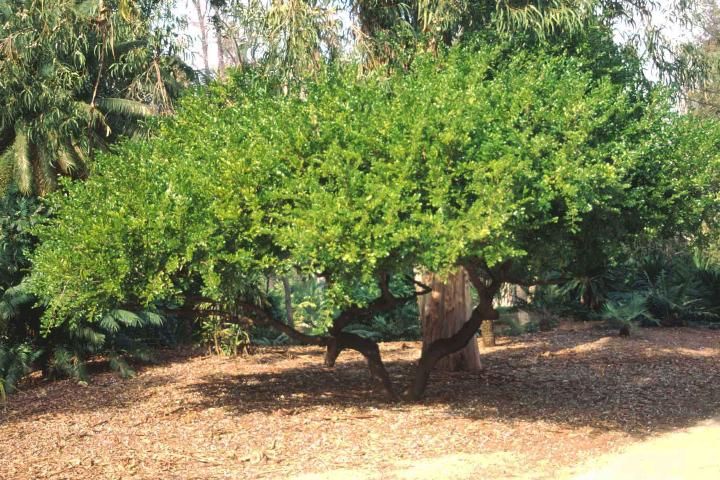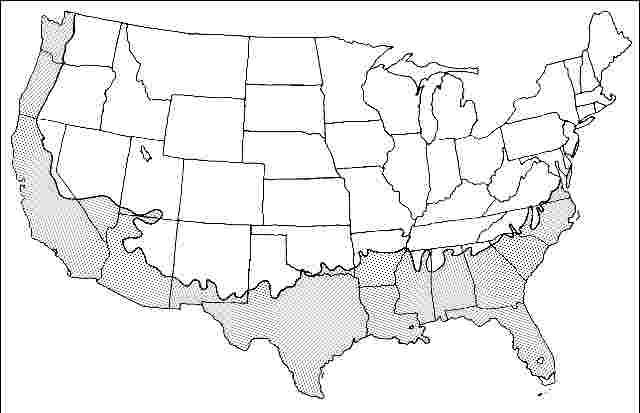Sophora secundiflora: Texas Mountain Laurel1
Introduction
Texas mountain laurel is a small North American native evergreen, growing 15- to 25-feet-tall with a 10-foot-spread but is capable of reaching up to 50-feet-tall in its native habitat. It has a narrow upright silhouette and dense foliage which lends itself well to being pruned into a tree form. Texas mountain laurel can be used as a specimen, patio, or street tree and is ideal for use as a screen, bank cover, or an espalier. The 2-inch-long, dark green leaves are glossy, thick, and leathery. In spring, Texas mountain laurel is a beautiful sight as it displays its dense, 2- to 5-inch-long, pendulous clusters of purple/blue, extremely fragrant flowers. Every so often, a white-flowered form can be found. The hairy seedpods which follow are 8-inches-long and ripen to reveal the inner, bright red seeds. These seeds are quite decorative and have been used to make necklaces but they are also poisonous. The fissured bark is dark gray to black.

Credit: Ed Gilman, UF/IFAS
General Information
Scientific name: Sophora secundiflora
Pronunciation: sah-FOR-uh seck-un-dih-FLOR-uh
Common name(s): Texas mountain laurel, mescalbean
Family: Leguminosae
USDA hardiness zones: 7B through 10A (Fig. 2)
Origin: native to North America
Invasive potential: little invasive potential
Uses: container or planter; reclamation; specimen; hedge; deck or patio; screen; parking lot island < 100 sq ft; parking lot island 100-200 sq ft; parking lot island > 200 sq ft; sidewalk cutout (tree pit); tree lawn 3-4 feet wide; tree lawn 4-6 feet wide; tree lawn > 6 ft wide; highway median; bonsai; street without sidewalk
Availability: somewhat available, may have to go out of the region to find the tree

Description
Height: 15 to 20 feet
Spread: 10 to 12 feet
Crown uniformity: symmetrical
Crown shape: upright/erect, round
Crown density: open
Growth rate: slow
Texture: fine
Foliage
Leaf arrangement: alternate (Fig. 3)
Leaf type: odd-pinnately compound
Leaf margin: entire
Leaf shape: elliptic (oval), obovate
Leaf venation: pinnate, brachidodrome
Leaf type and persistence: evergreen
Leaf blade length: less than 2 inches
Leaf color: green
Fall color: no color change
Fall characteristic: not showy

Flower
Flower color: purple
Flower characteristics: very showy
Fruit
Fruit shape: pod or pod-like, elongated
Fruit length: 1 to 3 inches, 3 to 6 inches
Fruit covering: dry or hard
Fruit color: red, white/gray
Fruit characteristics: does not attract wildlife; showy; fruit/leaves not a litter problem
Trunk and Branches
Trunk/bark/branches: branches don't droop; showy; typically multi-trunked; thorns
Pruning requirement: little required
Breakage: resistant
Current year twig color: green, brown
Current year twig thickness: medium
Wood specific gravity: unknown
Culture
Light requirement: full sun, partial sun, or partial shade
Soil tolerances: clay; sand; loam; alkaline; well-drained
Drought tolerance: high
Aerosol salt tolerance: moderate
Other
Roots: not a problem
Winter interest: no
Outstanding tree: yes
Ozone sensitivity: unknown
Verticillium wilt susceptibility: unknown
Pest resistance: free of serious pests and diseases
Use and Management
Usually found as a multi-trunked small tree, Texas mountain laurel can be trained to a single trunk in the nursery. Single-trunked nursery stock would make nice street trees for planting in small soil spaces, and where overhead space is limited by wires or other structures. Plant a row of Texas mountain laurel on 15 or 20 foot centers to form a nice canopy over a walk, or locate it close to a patio or deck. The bark on multi-trunked specimens shows off nicely when lit up at night from beneath the canopy.
Texas mountain laurel should be grown in full sun or partial shade on well-drained soil. This tough plant will tolerate hot, windy conditions and alkaline or wet soils but not compacted soil. Young trees may benefit from afternoon shading from the intense summer sun until they become established.
Propagation is by seed, cuttings, layering, or grafting. Trees on well-drained soils reportedly have a deep root system and will transplant poorly from the wild.
Pests and Diseases
No pests or diseases of major concern. Tender, young foliage is occasionally consumed by Uresiphita reveralis.


